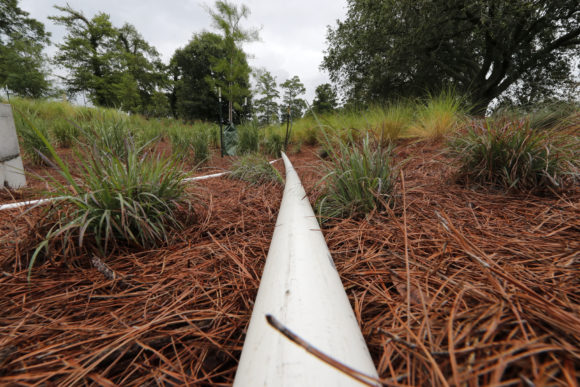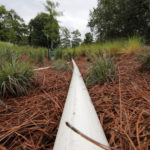For more than a century, New Orleans has depended on canals and pumps to get rid of stormwater in a city where about half the land is below sea level.
Now the bustling Mississippi River port that expanded by filling in wetlands is spending $270 million to create spaces for rainwater, such as the water garden planned on a 25-acre site provided by nuns who lived there before Hurricane Katrina.
The city is also installing underground holding tanks, porous pavement and other measures to reduce storm flooding and stress on huge pumps built in the 1910s.
“We’ve got a scenario for everything,” said Mary Kincaid, the city’s chief resilience officer.
Tropical storms can dump amazing amounts of rain, and hurricane season starts June 1. But smaller storms can also overwhelm storm drainage.
So cities around the country are taking creative steps to tame stormwater as climate change increases the number and intensity of hurricanes and other storms. Rising sea levels also elevate groundwater levels in coastal communities, reducing the soil’s ability to absorb rain.
“Stormwater runoff is one of the fastest growing sources of pollution,” the federal Environmental Protection Agency states on its website. “When rain hits rooftops, parking lots and roads instead of wetlands, forests and grasslands, it tends to run into storm drains that are directly connected to our waterways.”
In Pittsburgh, as in about 850 other areas where storm drains tie into sewer lines, sewage sometimes backs up into basements, floods streets and pours into rivers.
To attack one neighborhood’s problem, the Pittsburgh Water & Sewer Authority installed underground tanks and planted grasses and other native plants near a hilltop as a water-absorbent “bioswale.”
In New Orleans, where the highest neighborhoods reach 10 to 11 feet (3 to 3.3 meters) above sea level, Kincaid said, “We want to put in storage in the higher ground areas.” The aim is to capture the rain before it can reach lower ground and pool up.
Permeable Pavement
One such project is just off Bayou St. John and down the street from Parkway Bakery and Tavern, where owner Jay Nix switched his parking lot from concrete to much more expensive permeable pavement. That has noticeably lowered flooding in the restaurant, said Nix, who once had to use big plastic bags of “fish fry” breading as sandbags. He has high hopes for the city’s project, which features an underground storage tank and rain gardens.
“I think it’s going to work. It has to work,” he said.
Other techniques include planting trees and digging lagoons in wide roadway medians. Jurisdictions such as Portland, Oregon, require greenery-covered “ecoroofs” on some buildings.
Earlier, Portland bought 60 houses over 15 years, then turned a regularly flooded neighborhood into Foster Floodplain Natural Area. The work, which included creek restoration for migrating salmon and steelhead trout, increased the flood storage capacity six-fold—enough to fill nearly 70 Olympic-sized swimming pools.
Since the 63-acre park’s completion in 2012, an adjoining highway that flooded annually has flooded only once, officials said. And more than 600 nearby homes and businesses north of the highway also are seeing less flooding.
Nearly all money for New Orleans’ projects comes from the U.S. Department of Housing and Urban Development and the Federal Emergency Management Agency, so Kincaid said they’re not affected by new coronavirus-related budget holes.
The city won a $141 million HUD grant in 2016 to make New Orleans’ Gentilly neighborhood a “resilience district.”
Water Garden
The centerpiece will be a big water garden where the Congregation of St. Joseph’s convent was destroyed by Katrina flooding in 2005 and a later fire. The nuns are leasing the land to the city for $1 a year as long as it’s used for water management and environmental education.
“We wanted to do something that could benefit the future and that dealt with an immediate need,” said Sister Joan Laplace, 79, who lived at the convent on and off since 1960.
Atlanta’s $90 million in current and planned “green infrastructure” projects have included replacing more than four miles of neighborhood streets with porous pavers and adding 32 stormwater planters alongside.
Since Hurricane Irma toppled trees in 2017, Miami has moved away from planting palms and has planted nearly 4,700 live oaks and other trees that take up more water and provide shade.
Miami expects to finish updating its long-term storm water management plan next year, said Jane Gilbert, the city’s chief resilience officer.
Florida, once a coral reef, is now “one big porous limestone bed,” Gilbert said. “As the sea level rises, so do our groundwater levels,” reducing drainage.
“We have to look at as many ways as possible of absorbing, containing, slowing the flow of water,” she said.
When Hurricane Katrina broke New Orleans’ levees and killed more than 1,400 people, that raised global awareness of the limits of flood protection by dikes and pumping stations, said Stephane Hallegatte, a lead economist with the World Bank’s Global Facility for Disaster Reduction and Recovery.
“We need protection which can fail gracefully,” he said. “The advantage to a nature-based system is they tend not to fail in catastrophic fashion.”
Topics Catastrophe Flood Hurricane Pollution
Was this article valuable?
Here are more articles you may enjoy.




 Severity Was Up, But Will Falling Claims Volume Impact the Profession?
Severity Was Up, But Will Falling Claims Volume Impact the Profession?  FBI Involved After Two Florida Injury Lawyers Go Missing From Fishing Trip
FBI Involved After Two Florida Injury Lawyers Go Missing From Fishing Trip  Cloudy Future for Bourbon Has Jim Beam Closing Distillery for a Year
Cloudy Future for Bourbon Has Jim Beam Closing Distillery for a Year  Litigation Funding, Other New Laws in SE States Could Impact Liability Insurance
Litigation Funding, Other New Laws in SE States Could Impact Liability Insurance 

